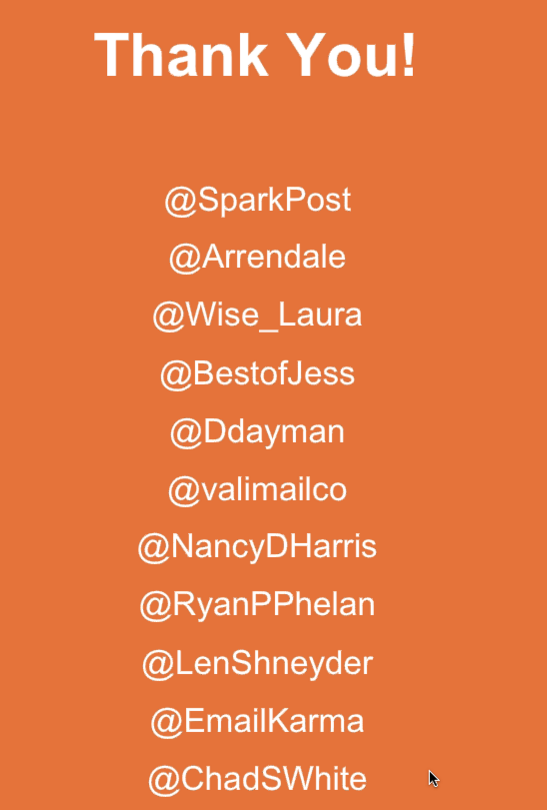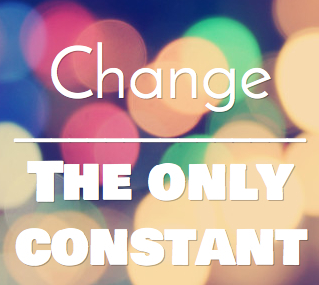Predictions
How much has changed and will change
I was on a call with a client today and they wanted to talk about the handshake agreement about bounce handling I mentioned last week. As I started to really talk about it, I realised how much has changed in the years since that meeting. 
Happy 2018
This is the time of year when everyone starts posting their predictions for the coming year. Despite over a decade of blogging and close to 2500 blog posts, I have’t consistently written prediction articles here. Many years I don’t see big changes on the horizon, so there’s not a lot to comment on. Incremental changes are status quo, nothing earth shattering there. But I’ve been thinking about what might be on the horizon in 2018 and how that will affect email marketing.
Email in 2020
 Late last year Litmus invited me to contribute to a whitepaper they were putting together about email in 2020. Today, they released Email Marketing in 2020. I am honored to be included in the list of experts that they chose.
Late last year Litmus invited me to contribute to a whitepaper they were putting together about email in 2020. Today, they released Email Marketing in 2020. I am honored to be included in the list of experts that they chose.
One of the things I find so so much fun in participating in this type of joint project is seeing what other people’s visions are. When Chad first contacted us, his request was very simple. He wanted 400-ish words on what we thought would change. We all approached it from our own perspectives. The final document really touches on a wide range of changes and gives an bright and rosy view of the future of email.
It’s hard to imagine I’ve had email for more than 25 years. It’s become such a fundamental and critical part of my life. I mean, sure I’m an email professional but it’s more than that. Some of my best friends I met over email. I’ve gotten multiple jobs based on my presence on email discussion lists. Steve and I met around email. One of the fun bits of M3AAWG is that I get to see friends I first met almost 20 years ago over email.
Email has really changed in the last decade. It is now a critical part of daily life for many people. Even social networking would be nowhere without an email address. Email really is the key to the digital kingdom. That’s not going to change.
Email being the key to the digital kingdom is a challenge. It lets nefarious people into our homes and into our lives and into our computers. A lot of very smart people are working on how to make email safer for us. I think it will be much safer in 2020, through the hard work and dedication of a lot of people.
I strongly encourage you to download the Email Marketing in 2020 white paper from Litmus. There is a lot of insight. It will be fun to see how much of what was said becomes reality.
More predictions for 2016
This morning I had the pleasure of participating in the SparkPost 10 experts in 50 minutes webinar. I am honored to be included with such a smart group of forward thinking leaders in the email space. The webinar was also live tweeted using #emailpros. I’ve put together some of my favorite tweets from today.
The webinar was also live tweeted using #emailpros. I’ve put together some of my favorite tweets from today.
What was fun for me was listening to the similarities and differences in our views. Multiple people mentioned authentication and security. Other people focused on display and creatives. Privacy and big data was another theme through multiple speakers. Our Canadian representative gave us a good summary of CASL enforcement. We also had some insightful comments about how deliverability is changing for the B2B market.
I’m definitely stealing B2H. I tweeted B2Host, but also saw someone use B2Human. Both work. It’s a term that really captures what deliverability is about. The human behind the email address is critical for getting to the inbox. B2H! Beautiful.
What to expect in 2016
 I don’t always do predictions posts, even though they’re popular. Most years I skip them because I don’t see major changes in the email space. And, I’m not the type to just write a prediction post just to post a prediction.
I don’t always do predictions posts, even though they’re popular. Most years I skip them because I don’t see major changes in the email space. And, I’m not the type to just write a prediction post just to post a prediction.
This year, though, I do see changes for everyone in the email space. Most of them center on finally having to deal with the technical debt that’s been accumulating over the past few years. I see ISPs and ESPs spending a lot of development effort to cope with the ongoing evolution authentication requirements.
When people started seriously looking at how to authenticate email, the first goal was getting organizations to implement the protocols. This was a practical concession; in order for a new protocol to be used it needs to be widely implemented. Phase one of authenticating email was simply about publishing protocols and getting organizations to use them.
During phase one, the organization that authenticated a mail hasn’t been important. In fact, the SPF spec almost guarantees that the ESP domain is the authenticated domain. In DKIM, the spec says any domain could sign as long as they could publish a public key in that domain’s domainkeys record.
ESPs took full advantage of this and lowered their own development overhead by taking most of the authentication responsibility on themselves. Their domains were in the 5321.from and they published the SPF records. Domains they control were in the d= and they generated and published the DKIM keys. Mail was authenticated without ESP customers having to do much.
We’ve hit the end of phase one. Most of the major players in the email space are authenticating outbound email. Many of the major players are checking authentication on the inbound. Phase one was a success.
We’re now entering phase two, and that changes thing. In phase two, SPF and DKIM are used as the foundation for user visible authentication. Neither SPF nor DKIM were designed to be user visible protocols. To understand what they’re authenticating you have to understand SMTP and email. Even now there are days when I begin talking about one of them and have to take a step back and think hard about what is being authenticated. And I use these things every day!
DMARC is the first of these end user visible protocols built on SPF and DKIM. It uses the established and widespread authentication to validate the user visible from address. This authentication requires that the d= value or the 5321.from address belong belong to the same domain in the visible from address. While you can pick whether the alignment between the visible from and the authentication is “strict” or “relaxed” you have no choice about the alignment.
Prior to DMARC no one really paid much attention to the domain doing the authentication. Authentication was a yes or a no question. If the answer was yes, then receivers could use the authenticated domain to build a reputation. But they weren’t really checking much in the way of who was doing the authentication.
In the push to deploy authentication, ESPs assumed the responsibility for authentication deployed ESPs took the responsibility and did most of the work. For many or most customers, authentication was as simple as clicking a checkbox during deployment. Some ESPs do currently let customers authenticate the mail themselves, but there’s enough overhead in getting that deployed that they often charged extra to cover the costs.
DMARC is rapidly becoming an expectation or even a full on requirement for inbox delivery. In order to authenticate with DMARC, the authenticating domain must be in the same domain space as the visible from. If senders want to use their own domain in the visible from, DNS records have to be present in that domain space. Whether it’s a SPF TXT record or a domainkeys record the email sender customer needs to publish the correct information in DNS. Even now, if you try to authenticate with DKIM through google apps, they require you to publish DNS records.
ESPs aren’t in a situation where they can effectively manage authentication alignment for all their customers. Hosting companies are in even worse shape when it comes to letting customers authenticate email. Developers are facing the fact they need to go back and rework their authentication code. Businesses are facing the fact they need to change their processes so customers can authenticate with DMARC.
It’s not just the infrastructure providers that are facing challenges with authentication. Senders are going to discover they can no longer hand authentication off to their ESPs and not worry about it. They’re going to have to get DNS records published by their own staff.
Getting DNS updates through some big companies is sometimes more difficult than it should be. I had one client a few years ago where getting rDNS changed to something non-generic took over a month. From an IT standpoint, changing DNS should require approvals and proper channels. Marketers may find this new process challenging.
And, if organizations want to publish reject policies for their domains, then they will have to publish records for every outside provider they use. Some of those providers can’t support DMARC alignment right now.
In 2016 a lot of companies will discover their current infrastructure can’t cope with modern authentication requirements. A lot of effort, both in terms of product development and software development, will need to be spent to meet current needs. This means a lot of user visible features will be displaced while the technical debt is paid.
These changes will improve the security and safety of email for everyone. It won’t be very user visible, which will give the impression this was a slow year for email development. Don’t let that fool you, this will be a pivotal year in email.
Are you ready for DMARC?
 The next step in email authentication is DMARC. I wrote a Brief DMARC primer a few years ago to help clear up some of the questions about DMARC and alignment. But I didn’t talk much about where DMARC was going. Part of the reason was I didn’t know where things were going and too much was unclear to even speculate.
The next step in email authentication is DMARC. I wrote a Brief DMARC primer a few years ago to help clear up some of the questions about DMARC and alignment. But I didn’t talk much about where DMARC was going. Part of the reason was I didn’t know where things were going and too much was unclear to even speculate.
We’re almost 2 years down the line from the security issues that prompted Yahoo to turn on p=reject in their DMARC record. This broke a lot of common uses of email. A lot of the damage created by this has been mitigated and efforts to fix it continue. There’s even an IETF draft looking at ways to transfer authentication through mailing lists and third parties.
For 2016, DMARC alignment is going to be a major factor in deliverability for bulk email, even in the absence of a published DMARC record.
Email predictions for 2015
Welcome to a whole new year. It seems the changing of the year brings out people predicting what they think will happen in the coming year. It’s something I’ve indulged in a couple times over my years of blogging, but email is a generally stable technology and it’s kind of boring to predict a new interface or a minor tweak to filters. Of course, many bloggers will go way out on a limb and predict the death of email, but I think that’s been way over done.
Even major technical advancements, like authentication protocols and the rise of IPv6, are not usually sudden. They’re discussed and refined through the IETF process. While some of these changes may seem “all of a sudden” to some end users, they’re usually the result of years of work from dedicated volunteers. The internet really doesn’t do flag days.
One major change in 2014, that had significant implications for email as a whole, was a free mail provider abruptly publishing a DMARC p=reject policy. This caused a lot of issues for some small business senders and for many individual users. Mailing list maintainers are still dealing with some of the fallout, and there are ongoing discussions about how best to mitigate the problems DMARC causes non-commercial email.
Still, DMARC as a protocol has been in development for a few years. A number of large brands and commercial organizations were publishing p=reject policies. The big mail providers were implementing DMARC checking, and rejection, on their inbound mail. In fact, this rollout is one of the reasons that the publishing of p=reject was a problem. With the flip of a switch, mail that was once deliverable became undeliverable.
Looking back through any of the 2014 predictions, I don’t think anyone predicted that two major mailbox providers would implement p=reject policies, causing widespread delivery failures across the Internet. I certainly wouldn’t have predicted it, all of my discussions with people about DMARC centered around business using DMARC to protect their brand. No one mentioned ISPs using it to force their customers away from 3rd party services and discussion lists.
I think the only constant in the world of email is change, and most of the time that change isn’t that massive or sudden, 2014 and the DMARC upheaval notwithstanding.
But, still, I have some thoughts on what might happen in the coming year. Mostly more of the same as we’ve seen over the last few years. But there are a couple areas I think we’ll see some progress made.